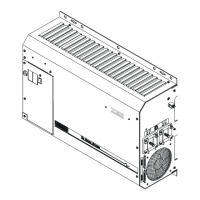OPERATION
Copyright Trace Engineering Company, Inc.
5916 - 195th Street N.E.
Arlington, WA 98223
Telephone: 360/435-8826
Fax: 360/435-2229
www.traceengineering.com
PS Series Inverter/Charger
Part No. 3597
Rev. D: November 23, 1999
Page
57
The efficiency of the PS Series is extremely good (>85%). The inverter reaches high efficiency at very low
AC load levels, which is important because the inverter often spends the majority of the time at the lower
power range. The high efficiency is maintained over a wide power range. Only when operating at high
power levels at or above the continuous power levels does the efficiency begin to drop off. Since this
usually only occurs for short periods of time, the impact may be negligible.
If your application involves the inverter powering heavy loads for significant periods of time, selecting a
model with a higher continuous power rating and a higher DC input voltage would improve the operation
of the system. Since the low power efficiency of all the PS Series is extremely good, oversizing the
inverter does not reduce system performance.
INVERTER CAPACITY VS TEMPERATURE
The current protection circuit in the PS Series Inverter/Charger is temperature compensated, therefore
the maximum sized load that the inverter can run changes with temperature. As the temperature of the
power devices (FET’s) increase, the allowable current is reduced. When the available current is reduced,
the capacity of the inverter to run loads is reduced.
The graph below shows the effect temperature has on the inverter’s capacity to run loads, notice that the
inverter reduces its capacity at temperature above 25 °C. The temperature derating graph assumes that
the inverter is at sea level and the airflow to the inverter is unrestricted.
Figure 19, Inverter Capacity vs. Temperature
Temperature Derating for PS Series Inverters
0
20
40
60
80
100
120
25 32.5 40 47.5 55 62.5 70 77.5 85 92.5 100
Percent
of
total
rated
power
capacity
Temperature °C

